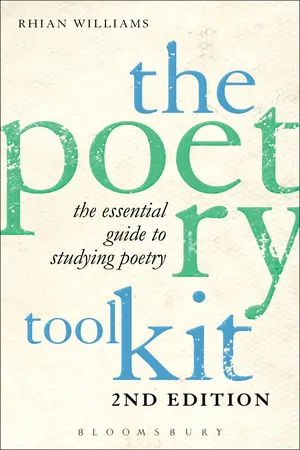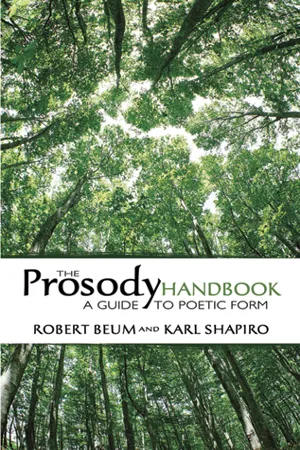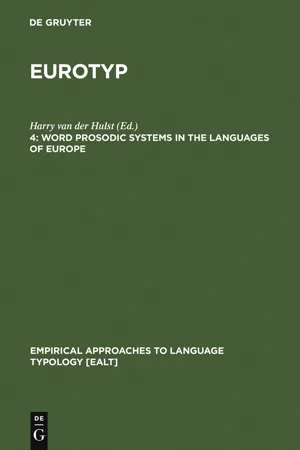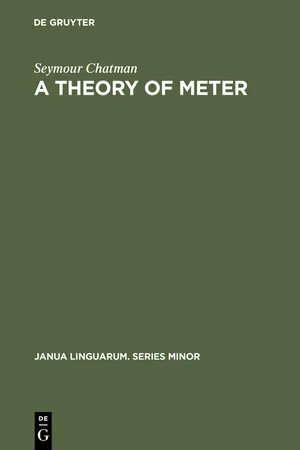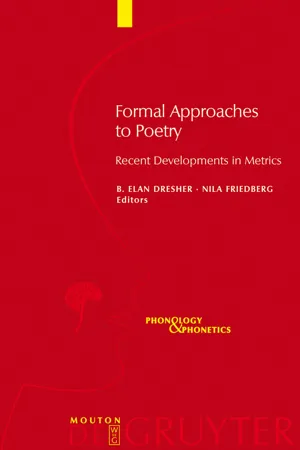Literature
Metrical Foot
A metrical foot is a unit of measurement in poetry that consists of a specific combination of stressed and unstressed syllables. It forms the basis of the rhythmic structure of a line of poetry and helps to create the overall meter of a poem. Common types of metrical feet include iambic (unstressed, stressed), trochaic (stressed, unstressed), and anapestic (unstressed, unstressed, stressed).
Written by Perlego with AI-assistance
9 Key excerpts on "Metrical Foot"
- eBook - PDF
- Rhian Williams(Author)
- 2013(Publication Date)
- Bloomsbury Academic(Publisher)
The overall type of metre employed in a poem may also be described according to the stress pattern seen most commonly in each foot: � l Falling metre : lines containing feet that end on an unstressed syllable. � l Rising metre : lines containing feet that end on a stressed syllable. Finally, in order to fit with a poem’s overall metre (but sometimes in order to introduce a chatty or informal tone to the poem) individual words may be altered to fit foot-patterns. This happens by changing the pronunciation or spelling by dropping or adding syllables – this is known as metaplasm , and it occurs in various ways, some of the most common being: � l Synaeresis : when two consecutive vowel sounds within a word are contracted into one. Example: in the rhyme ‘roses are red, violets are blue’, violets is pronounced ‘vi’lets’ to fit with the metre. � l Synaloepha (or elision ): when a word ending with a vowel is followed by word starting with a vowel, and those two sounds are contracted into one. Prosody 149 Example: ‘th’other’ for ‘the other’ in ‘On th’other side’ (John Milton, ‘Book IX’, Paradise Lost (1667), l. 888). ● ● Syncope : when a syllable within a word is cut away by dropping either a consonant between two vowels or a vowel between two consonants. Example: ‘over’ becomes ‘o’er’ in ‘May fan the cool air gently o’er my rest’ (John Keats, ‘Sleep and Poetry’ (1817), l. 112); later in the same poem ‘slumbering’ is pronounced ‘slumb’ring’ in ‘’Tis might half-slumbering on its own right arm’ (l. 237). English verse tends to use only two- or three-syllable feet and some metrical systems insist that an English foot can only contain one stressed syllable: if more than one occurs the foot must split into two diferent feet. he practice of identifying feet can be a fraught business, reminiscent of the joke about mixing a martini: if ever you are lost alone in the wilderness start mixing a martini – in no time someone will turn up to tell you you’re doing it wrong. - Further more, two people with a similar accent are perfectly capable of disagreeing over the due emphasis which should be placed upon individual words within a given line of poetry. The underlying problem here is that we 74 Poetry expect to find metrical analysis, with its pseudo-scientific jargon, to be an exact science.And it’s not.While it is unlikely that one can generate the same number of metrical accounts of a given line of poetry as the number of readings which critical ingenuity can provide for the meaning of a literary work, it is perfectly possible to generate two – and sometimes more – equally plausible metrical accounts of a line of verse. A contentious line from Paradise Lost will not be interpreted prosodologically from as wide a range of positions as, say, the debates over the significance of Satan in the poem; however, critics can, and do, quarrel over the way in which a particular line can be scanned. Prosodological analysis of metre, like so much else in literary criticism, is to a certain extent a matter of opinion. Metre gestures towards objective scientific analysis but remains an art with a significant degree of subjectivity within it. 4.2 the key metrical units The core terms in the study of metre are syllable , foot and stress . A syllable is a word, or portion of a word, made by a single effort of the organs of speech. It either forms a word or is an element of a longer word; thus, in the previous sentence, ‘a’, ‘is’, ‘word’ are examples of single-syllable words (monosyllables), whilst the two-syllable words ‘portion’, ‘single’ and ‘organs’ are disyllabic and ‘syllable’ itself polysyllabic (that is, a word containing three or more syllables). A line of verse, like all other examples of language in use, subdivides into syllables. It can contain almost any practical number of syllables up to eighteen (though longer lines than this, though freakishly unusual, have been used).
- eBook - ePub
- Mick Short(Author)
- 2018(Publication Date)
- Routledge(Publisher)
But because the line lengths are now very irregular we do not feel that the rhythmic properties of each line are parallel to one another. It is this extra regularity which makes metre what it is. Metred poems, then, are poems where the line lengths and rhythmical patterns within the lines are close enough for us to feel a basic pattern of equivalence from line to line. This is why explaining how the different poetic metres work is an important aspect of explaining rhythm in poetry. 5.4 Different kinds of metre Metre in English verse is a level of organisation which is based upon a two—term contrast between positions in a line which should contain strong and weak syllables. Let us use the traditional terms ictus (/) and remiss (X) to refer to these strong and weak positions respectively. If we restrict ourselves for the moment to a situation where these two positions are only allowed to contain one syllable each, we can see that there are two possible patterns of weak and strong events, X /('di dum') and / X ('dum di'). These two elementary patterns are essential to an understanding of English metrics. The first pattern, X / ('di dum') is traditionally called the iamb and the / X ('dum di') pattern is called the trochee. The basic metrical unit of one strong plus one weak (ictus plus remiss) position is traditionally referred to as the Metrical Foot. Thus we can find iambic feet, trochaic feet, and also other combinations when the basic unit is expanded to include more than two syllables in the remiss of the foot (the Metrical Foot must have one and only one ictus syllable, but can normally have from zero to three remiss syllables). Below I list, with illustrative examples, the major foot structures that can be found with any regularity. Some are much more common than others, the iambic foot being by far the most widespread in English verse - Mick Short(Author)
- 2018(Publication Date)
- Routledge(Publisher)
Now let us restrict our discussion for a moment to lines of poetry with iambic ·('di dum') feet. Normally, iambic lines will consist of more than one iamb, and poets can choose how 132 Exploring the language of poems, plays and prose many iambs to have as the basic line-template for particular poems. One particular form has dominated English poetry since the fifteenth-century, however, namely a line with five iambs, as in the following example: Example 2 X I X I X I X I X I Then tooke the angrie witch her golden cup X I X I X I X IX I Which still she bore, replete with magick artes; (Edmund Spenser, The Faerie Queene, I, viii, 14) This kind of line is found throughout the verse of Shakespeare, Milton and Wordsworth, for example, and is called iambic pentameter (literally 'iambic five metre'). We might call the iambic pentameter line the metrical norm for English poetry from the fifteenth-century onwards. Other possibilities can, of course, be found: 1. Manometer 2. Dimeter 3. Trimeter 4. Tetrameter 5. Pentameter 6. Hexameter one foot line two feet lines three feet lines four feet lines five feet lines six feet lines These 'number of feet' combinations can in principle involve any kind of foot as the basic unit, and various stanza forms can have patterns involving differing numbers of feet from line to line (for example, Keats's 'Song', which we analysed in 2.2. 7, has tetrameters in the first and third lines of each verse and trimeters in the second and fourth lines). But it is the iamb in units of five which is the dominant English verse form. Exercise 1 (a) Re-examine Keats's 'Song' in 2.2.7. What is the rhythmical effect created by having a 'missing foot' in the second and fourth lines? (b) Below are a series of extracts from poems. Work out, for each example, what the basic foot unit is and how many feet there are to the line.- eBook - ePub
The Prosody Handbook
A Guide to Poetic Form
- Robert Beum, Karl Shapiro, Karl Shapiro(Authors)
- 2012(Publication Date)
- Dover Publications(Publisher)
The reader is induced to look for and is thus far satisfied with continually finding a certain order. Marked changes in that pattern establish a sense of contrast; the reader is put on his guard. Variation beyond that which is needed for securing rhythmic variety and now and then for a sudden emphasis brought about by metrical surprise, makes the reader wonder why the pattern has changed; and if nothing in the sense of the verse seems to warrant it, the variance is likely to be perceived as mere irrationality or inconsistency. The poet himself, in the midst of composition, is certain to feel obliged to conform more or less continually to his adopted pattern: radical and repeated departures from the scheme are almost inevitably bound up with changes of tone, and the careful preservation and modulation of tone is the very essence of all successful imaginative discourse. Poems that begin as ballads keep on being ballads to the end, and iambic sonnets do not suddenly metamorphose into trochaic couplets. And so, this much at least may be said: the poet tends to adhere to his adopted pattern of stresses and nonstresses; and that pattern is susceptible to being analyzed into units or “feet,” or it would not be a pattern. A further point in defense of the “foot approach” begs admittance. Until quite recent times, English poets were, almost to a man, heirs of classical culture, which included classical verse and classical prosodic concepts and terminology; and their poetry invariably was born and bred on the foot. It would be foolish, then, to disregard in a modernist or intuitionist frenzy the whole business of the foot and its attendant implications. If any point in prosodic matters does not require debate, it is that English poets were early made and long kept acutely conscious of the classical tradition. In answer to the other question, it must be said that it is important to discover the metrical pattern of verse. And, once again, for a very simple reason - eBook - PDF
- Regna Darnell, Judith T. Irvine, Richard Handler, Regna Darnell, Judith T. Irvine, Richard Handler(Authors)
- 2010(Publication Date)
- De Gruyter Mouton(Publisher)
The Musical Foundations of Verse Miss Amy Lowell's paper on The Rhythms of Free Verse is particu-larly important for the attention it calls to the concept of a time unit in certain types of verse as distinct from the metric unit determined by syllabic structure alone or by syllabic structure dominated by stress. To quote Miss Lowell: For years I had been searching the unit of vers libre, the ultimate particle to which the rhythm of this form could be reduced. As the 'foot' is the unit of 'regular verse,' so there must be a unit in vers libre. I thought I had found it. The unit was a measurement of time. The syllables were unimportant, in the sense that there might be many or few to the time interval. This passage was all the more pleasing to me in that I found confirmation in it of a feeling that had gradually and strongly come to be borne in on me in the reading of certain types of free verse, the feeling that in some of the more artistic products of the imagist school, for instance, there was present a ten-dency to a rhythm of time pulses that operated independently, more or less, of the number of syllables. A line of verse, for instance, that had considerable length to the eye might quite readily, I conceived, be looked upon as the exact prosodic equivalent of a line of perhaps but half of its length, if the rates of articulation of the two lines differed sufficiently to make their total time-spans identical or approximately so. Hence the metrical irregularity of one type of free verse might be and, in at least some cases, as I felt convinced, was consciously or unconsciously meant to be, interpreted as a merely optical but not fundamentally auditory irregularity. This, in musical terminology, would be no more than saying that two equivalent measures (metric units) may, and frequently are, of utterly different constitution both as regards the number of tones (syllables) in the melodic line (flow of words) and the distribution of stresses. - Harry van der Hulst(Author)
- 2008(Publication Date)
- De Gruyter Mouton(Publisher)
24 Harry van der Hülst at the lowest level of the rhythmic organization, but not quaternary rhythm (26 c): 23 (26) a. χ χ χ χ χ σ σ σ σ σ σ σ σ σ b. χ χ χ σ σ σ σ σ σ σ σ σ c. χ χ χ σ σ σ σ σ σ σ σ σ In the previous section we have suggested that rhythmic non-primary accents can be regarded as properties of a domain that is smaller than the word, which we called the foot. It would seem, then, that we must construct a set of algorithms for assigning foot structure. These form the central core of what is known as metrical theory. We will turn to this in the next section. It will become clear that the presence of foot structure enables metrical theory to reduce primary accent rules to rules placing primary accent on the right-most or left-most foot accent: (27) Primary accent rules i. χ 2 χ * χ / ) 1 ii. χ 2 χ χ / ( - 1 We will also see that metrical theory explains the culminative nature of accent, i. e., its once-per-domain-occurrence, 24 by viewing accents as heads of these domains. Thus, non-primary accents will be presented as heads of feet, and primary accents as heads of words. On the assumption that domains can have no more than one head, culminativity follows. 1.3.2. The foot I will start the discussion with the form of and the motivation for the category foot. The term foot will be familiar from the study of poetic meter. Poetry can, as we know, make use of a number of different foot types, among which the trochee and the iamb are the most familiar ones. Both Metrical Foot types combine two syllables. In this sense, trochaic and iambic feet are bounded or Word accent 25 binary constituents. The difference between them lies in their salience pattern. In trochaic feet, the first syllable is more salient than the second and in iambic feet the opposite relation holds. In some theories of poetic meter, one finds the following notation for trochaic and iambic lines of verse (S = strong, W = weak; cf. Hayes 1983): (28) a.- eBook - PDF
- Seymour Chatman(Author)
- 2016(Publication Date)
- De Gruyter Mouton(Publisher)
256. See also the essay by Donald Davie, The Relation Between Syntax and Music in Some Modern Poems in English, Poetics (The Hague, 1961), pp. 203-214. 11 T. S. Eliot uses the term music in an unrelated sense, as a kind of semantic reverberation: The music of a word is, so to speak, at a point of intersection: it arises from its relation first to the words immediately preceding and following THE FUNCTION OF METER 191 If it is not profitable to isolate meter as pure sound or as a surrogate of music because its resources are too simple to be inter-esting, can we isolate pure metrical value in some other way? Me-trical discussion often seems tacitly to assume that we can. Elements of meter - feet, lines, or stanzas - are often evaluated per se. We read, for example, that anapests tend to be independent and self-sufficient, 12 that six-foot lines drag themselves with a lumbering gait, although they are more readily held together by the impe-tuosity of the anapestic run; 13 that dactylic meter is all too musical, or musicalesque, providing bad poets, like Poe, with a ready-made, reach-me-down music ; 14 that free verse is basically deficient because it allows no possibility of substitution, no normal foot to depart from. 15 Values may be interpreted in quasi-meta-phorical terms like fluidity or speed: groups in rising rhythm tend to detach themselves more sharply, while falling rhythm tends to produce a more smooth and even continuity of flow; in musical terms the effects are respectively staccato and legato. 18 The spondee is solemn and slow. The pyrrhich is very light . . . the anapest is grave and swift too . . . the amphibrach has the most bound and canter - it leaps like waves. The antispast is rocking and tumultuous: it gives a richer rhythm than all others . . . The cretic is brisk and tramping. The choriamb is liquid and eloping. - eBook - PDF
Formal Approaches to Poetry
Recent Developments in Metrics
- B. Elan Dresher, Nila Friedberg, B. Elan Dresher, Nila Friedberg(Authors)
- 2008(Publication Date)
- De Gruyter Mouton(Publisher)
Different poetic traditions and dif-ferent periods of a tradition accept a dissimilar number of syllables stressed in a way uncharacteristic of the positions they occupy. The contrast in stress- 54 Marina Tarlinskaja ing needs to be strong enough to be recognized by the audience. How strong should the contrast be? Analyses of large portions of texts by many authors working in different genres might give us a clue. The poet’s own opinion of the verse form does not always serve as an indicator. Coleridge declared that in Christabel he had created a new form of verse that depended only on the number of stresses in the line; and yet the form turned out to be loose iambic tetrameter; and what Frost called “loose iambic” (as did Halle and Keyser in 1998) turned out to be a strict stress-meter, the so-called “dolnik” (Tarlinskaja 1993). Having established overall metricality of a text, we turn to metricality of individual lines. Metricality of a line is best viewed historically and empiri-cally: what types of lines were accepted as metrical by poets of a particu-lar literary tradition and epoch? In other words, which types of lines were used regularly, and which are exceptions? If we establish that, on the whole, Frost’s long poems The Generation of Men , or Maple , or Wild Grapes , are in iambic pentameter, and then discover that lines of the type “With a swish in the grass. What if the others <...>” ( The Generation of Men 23) appear in his texts infrequently but consistently (75 times, or in 2.5% of the 3,000 lines ex-amined) they must have been metrical for Frost, but not for Pope: in Pope’s iambs such lines never occur. If lines like “But forgot to put the leaf back in closing” appear only six times in Frost’s 3,000 lines (0.2% of lines) then they should probably be considered anomalous. Should the number of such lines go up, the text might become transitional, from iambic to syllabic (Tarlins-kaja and Teterina 1974), and with more anomalous lines, purely syllabic.
Index pages curate the most relevant extracts from our library of academic textbooks. They’ve been created using an in-house natural language model (NLM), each adding context and meaning to key research topics.
